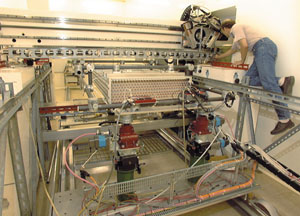
Covering a volume of 17 000 m3, the muon system of the ATLAS experiment at CERN’s Large Hadron Collider (LHC) will be one of the largest particle detector systems ever built. Some 46 institutes around the world are involved in constructing its 1200 Monitored Drift Tube (MDT) chambers, which will provide precision measurements of muon trajectories, along with the trigger chambers that will be associated with them. The trigger chambers are being built in China, Israel, Italy, Japan and Russia. Their production is a formidable undertaking in its own right, but it is the precision MDTs that present the larger challenge to the ATLAS collaboration.
Precision is paramount for the MDTs, and uniformity between the modules coming from different parts of the world has to be carefully controlled. To this end the collaboration has established a stringent quality-control procedure for the principal MDT production sites. A total of 17 sites in nine countries are involved in the production of MDTs. Much of the tooling is locally produced, so not all of the sites are identically equipped, yet they must produce identical chambers with wire positions known to 20 mm for all 400 000 channels of the MDT system.
The quality-control procedure begins with a site inspection. Once the okay has been given, a site produces its so called module-zero chamber and ships it to CERN. A dedicated X-ray tomograph (March p3) then measures the wire positions to ensure that they are all within tolerance before the green light is given for series production to begin. If the module-zero chamber does not pass the tomograph test, a second must be produced before the site can begin production. By the end of July, 11 production sites were operational.
However, the quality-control procedure does not end there. Each tube is entered in a database and barcoded so that, should problems arise in any tube, its entire history can easily be traced. Once a production site is operational, a random sample of about 10% of its production is tested on the CERN tomograph to ensure that standards are being maintained.
The last constructed MDT is scheduled to arrive at CERN in the summer of 2004 for final assembly of MDTs and associated trigger chambers. The complete detector is scheduled to be installed in the ATLAS experimental hall between 2004 and the beginning of 2005, along with the completion of the ATLAS detector, to be ready to register the LHC’s first collisions.





